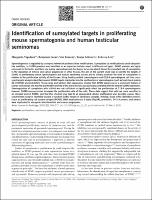Please use this identifier to cite or link to this item:
https://hdl.handle.net/20.500.12202/9939| Title: | Identification of sumoylated targets in proliferating mouse spermatogonia and human testicular seminomas |
| Authors: | Vigodner, Margarita Lucas, Benjamin Kemeny, Stav Schwartz, Tamar Levy, Rebecca |
| Keywords: | proliferation seminoma spermatogonia sumoylation |
| Issue Date: | 2020 |
| Publisher: | Wolters Kluwer Medknow Publications, 2020. |
| Citation: | Vigodner, M., Lucas B., Kemeny, S., Schwartz T., & Levy, R. (2020). Identification of sumoylated targets in proliferating mouse spermatogonia and human testicular seminomas. Asian J Androl, 22(6), 569-577. |
| Series/Report no.: | Asian J Androl,;22(6) |
| Abstract: | ORIGINAL ARTICLE Identification of sumoylated targets in proliferating mouse spermatogonia and human testicular seminomas Vigodner, Margarita1,2,; Lucas, Benjamin1; Kemeny, Stav1; Schwartz, Tamar1; Levy, Rebecca1 Author Information 1Department of Biology, Stern College, Yeshiva University, New York, NY 10016, USA 2Department of Developmental and Molecular Biology, Albert Einstein College of Medicine, Bronx, NY 10461, USA Correspondence: Dr. M Vigodner (vigodner@yu.edu) Received September 27, 2019 Accepted January 17, 2020 Asian Journal of Andrology 22(6):p 569-577, Nov–Dec 2020. | DOI: 10.4103/aja.aja_11_20 Open Abstract Spermatogenesis is regulated by a complex network of posttranslation modifications. Sumoylation (a modification by small ubiquitin-like modifiers, or SUMO proteins) was identified as an important cellular event in different cell types. SUMO proteins are highly expressed in the testis, and their role during spermatogenesis has begun to be elucidated. Given the important role of sumoylation in the regulation of mitosis and cancer progression in other tissues, the aim of the current study was to identify the targets of SUMO in proliferating mouse spermatogonia and human seminoma tissues and to initially examine the level of sumoylation in relation to the proliferative activity of the tissues. Using freshly purified spermatogonia and C18-4 spermatogonia cell line, mass spectrometry analysis identified several SUMO targets implicated into the proliferation of spermatogonia (such as heat shock protein 60 [HSP60] and prohibitin). Tissue array and western blot approaches showed that SUMO expression is a prominent feature of human seminomas and that the proliferative activity of the tumor tissues was positively correlated with the level of SUMO expression. Downregulation of sumoylation with si-RNA was not sufficient to significantly affect the proliferation of C18-4 spermatogonia; however, SUMO overexpression increased the proliferation rate of the cells. These data suggest that cells are more sensitive to an elevated level of SUMO, and that this situation may lead to an upregulated cellular proliferation and, possibly, cancer. Mass spectrometry analysis identified around a hundred SUMO targets in seminoma samples. Notably, many of the identified proteins (such as proliferating cell nuclear antigen [PCNA], DNA topoisomerase 2-alpha [Top2A], prohibitin, 14-3-3 protein, and others) were implicated in oncogenic transformation and cancer progression. |
| Description: | Research article / Open access |
| URI: | https://journals.lww.com/ajandrology/fulltext/2020/22060/identification_of_sumoylated_targets_in.5.aspx https://hdl.handle.net/20.500.12202/9939 |
| ISSN: | 1008-682X 1745-7262 |
| Appears in Collections: | Stern College for Women -- Faculty Publications |
Files in This Item:
| File | Description | Size | Format | |
|---|---|---|---|---|
| Vigodner 2020 OA identification_of_sumoylated_targets_in.5.pdf | 812.87 kB | Adobe PDF |  View/Open |
This item is licensed under a Creative Commons License

